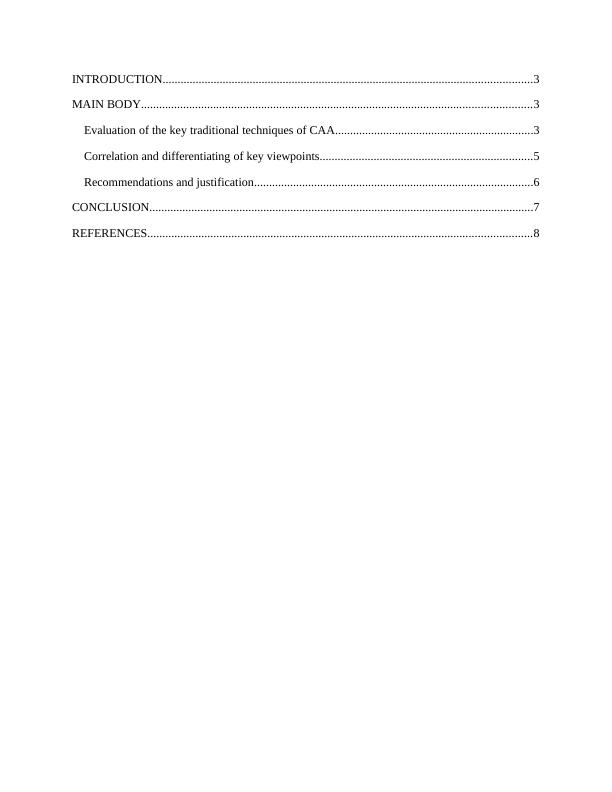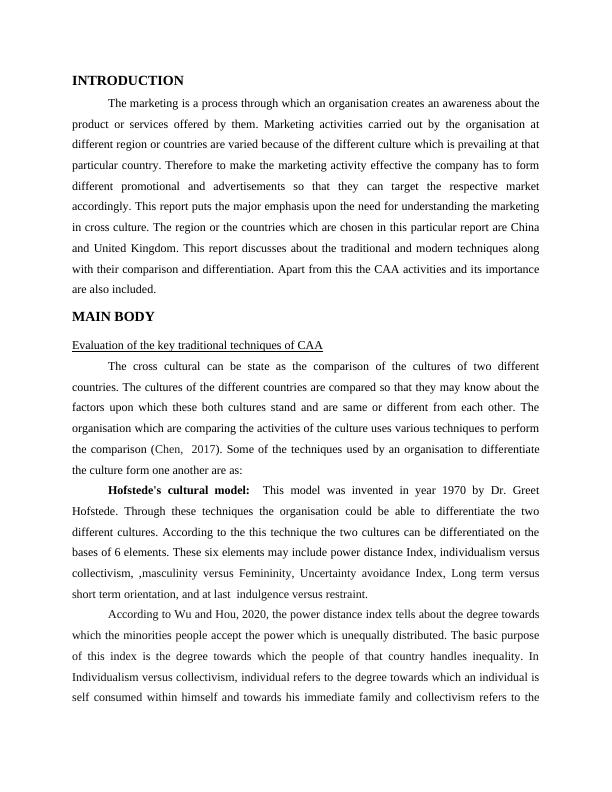Understanding Marketing in Cross Culture: A Comparison of Traditional Techniques
Added on 2023-01-05
9 Pages1902 Words77 Views
Across Cultures
Contents
Contents

INTRODUCTION...........................................................................................................................3
MAIN BODY..................................................................................................................................3
Evaluation of the key traditional techniques of CAA..................................................................3
Correlation and differentiating of key viewpoints.......................................................................5
Recommendations and justification.............................................................................................6
CONCLUSION................................................................................................................................7
REFERENCES................................................................................................................................8
MAIN BODY..................................................................................................................................3
Evaluation of the key traditional techniques of CAA..................................................................3
Correlation and differentiating of key viewpoints.......................................................................5
Recommendations and justification.............................................................................................6
CONCLUSION................................................................................................................................7
REFERENCES................................................................................................................................8

INTRODUCTION
The marketing is a process through which an organisation creates an awareness about the
product or services offered by them. Marketing activities carried out by the organisation at
different region or countries are varied because of the different culture which is prevailing at that
particular country. Therefore to make the marketing activity effective the company has to form
different promotional and advertisements so that they can target the respective market
accordingly. This report puts the major emphasis upon the need for understanding the marketing
in cross culture. The region or the countries which are chosen in this particular report are China
and United Kingdom. This report discusses about the traditional and modern techniques along
with their comparison and differentiation. Apart from this the CAA activities and its importance
are also included.
MAIN BODY
Evaluation of the key traditional techniques of CAA
The cross cultural can be state as the comparison of the cultures of two different
countries. The cultures of the different countries are compared so that they may know about the
factors upon which these both cultures stand and are same or different from each other. The
organisation which are comparing the activities of the culture uses various techniques to perform
the comparison (Chen, 2017). Some of the techniques used by an organisation to differentiate
the culture form one another are as:
Hofstede's cultural model: This model was invented in year 1970 by Dr. Greet
Hofstede. Through these techniques the organisation could be able to differentiate the two
different cultures. According to the this technique the two cultures can be differentiated on the
bases of 6 elements. These six elements may include power distance Index, individualism versus
collectivism, ,masculinity versus Femininity, Uncertainty avoidance Index, Long term versus
short term orientation, and at last indulgence versus restraint.
According to Wu and Hou, 2020, the power distance index tells about the degree towards
which the minorities people accept the power which is unequally distributed. The basic purpose
of this index is the degree towards which the people of that country handles inequality. In
Individualism versus collectivism, individual refers to the degree towards which an individual is
self consumed within himself and towards his immediate family and collectivism refers to the
The marketing is a process through which an organisation creates an awareness about the
product or services offered by them. Marketing activities carried out by the organisation at
different region or countries are varied because of the different culture which is prevailing at that
particular country. Therefore to make the marketing activity effective the company has to form
different promotional and advertisements so that they can target the respective market
accordingly. This report puts the major emphasis upon the need for understanding the marketing
in cross culture. The region or the countries which are chosen in this particular report are China
and United Kingdom. This report discusses about the traditional and modern techniques along
with their comparison and differentiation. Apart from this the CAA activities and its importance
are also included.
MAIN BODY
Evaluation of the key traditional techniques of CAA
The cross cultural can be state as the comparison of the cultures of two different
countries. The cultures of the different countries are compared so that they may know about the
factors upon which these both cultures stand and are same or different from each other. The
organisation which are comparing the activities of the culture uses various techniques to perform
the comparison (Chen, 2017). Some of the techniques used by an organisation to differentiate
the culture form one another are as:
Hofstede's cultural model: This model was invented in year 1970 by Dr. Greet
Hofstede. Through these techniques the organisation could be able to differentiate the two
different cultures. According to the this technique the two cultures can be differentiated on the
bases of 6 elements. These six elements may include power distance Index, individualism versus
collectivism, ,masculinity versus Femininity, Uncertainty avoidance Index, Long term versus
short term orientation, and at last indulgence versus restraint.
According to Wu and Hou, 2020, the power distance index tells about the degree towards
which the minorities people accept the power which is unequally distributed. The basic purpose
of this index is the degree towards which the people of that country handles inequality. In
Individualism versus collectivism, individual refers to the degree towards which an individual is
self consumed within himself and towards his immediate family and collectivism refers to the

End of preview
Want to access all the pages? Upload your documents or become a member.
Related Documents
Managing Across Borders: Cultural Profile and Hofstede's Cultural Dimensionslg...
|11
|1757
|417
International Marketing and Communications Managementlg...
|16
|3051
|33
Marketing across Cultures Assignment CW1.lg...
|8
|2089
|48
Marketing across Cultureslg...
|7
|2069
|30
Summary of Hofstede’s Cultural Dimensionlg...
|4
|1171
|392
International management assignmentlg...
|8
|2187
|62
